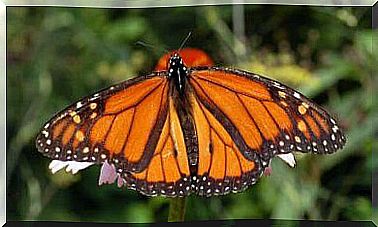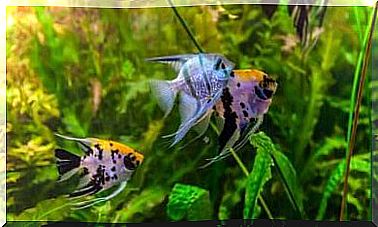Anteater: Characteristics And Behavior
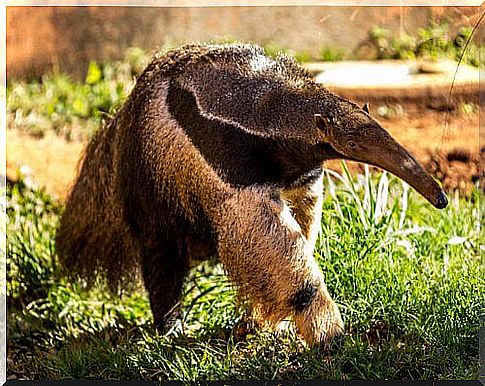
The anteater, known for its long snout and sticky tongue, lives in South and Central America. As the name implies, its diet is based on feasting on ants, which are trapped in a more than efficient way. In this article we will talk about the anteater, one of the most fascinating and surprising mammals from the point of view of the evolutionary path.
Characteristics and feeding of the anteater
It belongs to the family of placental mammals , has a robust body – on average it weighs 40 kilos by 130 centimeters in length – and its fur varies from gray to black and beige. The forelegs are long and have strong, curved nails, which allow them to climb trees or easily overcome dense vegetation.
The anteater’s head is small compared to the body and its long snout houses a tongue up to 60 centimeters long. It has no teeth but has an excellent sense of smell, which allows it to find food at great distances.
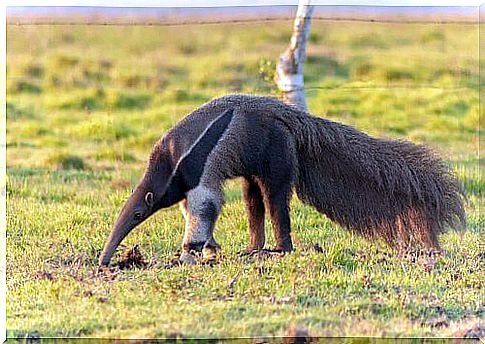
The anteater’s diet consists of termites and ants – it is a myrmecophagus animal – and the technique of obtaining food is very effective. It first breaks the anthill or termite mound with the claws of its paws, then inserts its nose over the opening and lets out its viscous tongue to catch its tiny prey.
Habitat and behavior of the anteater
The anteater lives in forests, grasslands, mountains or savannas. Any place where there are ants or termites! It is a passive, peaceful and calm mammal that attacks only to defend itself when necessary. On the other hand, its main predators are jaguars, pumas and wolves. His technique is to “embrace” the enemy and sink his claws hard in order to dissuade him.
It is an animal with solitary habits and seeks the company of a partner only during the period of heat or when the mother is engaged in raising puppies. Females give birth to only one specimen at a time after 190 days of gestation. From the moment of birth, the baby anteater is carried on the back by the parent, to which it clings with its claws, camouflaging itself in the maternal fur.
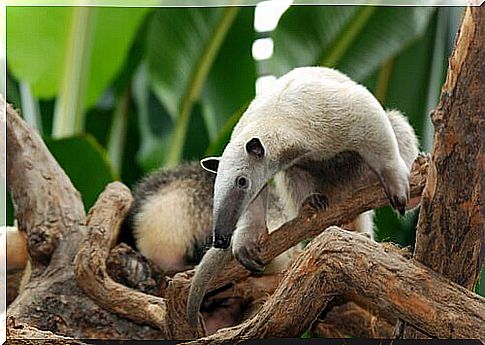
Anteater species
Although the general characteristics are the same for all anteaters, we can highlight four distinct species, which we present to you in the list below:
1. Giant anteater
Also known as the ant bear ( Myrmecophaga tridactyla ), it is the largest insectivore in the world, has diurnal habits and returns to its cave at night to protect itself from the cold. Use your nose to find food and, once on your prey, unleash its powerful claws.
It moves with great speed, despite its size and eats with a voracious appetite. He introduces the language 150 times a minute, inside an anthill. His technique is very effective and serves to prevent ants from pinching him. Unlike other species, the giant anteater has no prehensile tail.
2. Dwarf anteater
It is also known as a pygmy anteater ( Cyclopes didactylus ) and is the most difficult to find, due to its shyness and stealth when walking on trees, from which it almost never gets off. Its fur is beige in color, it has a shorter muzzle than the previous one, it also feeds on larvae (in addition to ants) and is not very active. Its prehensile tail allows it to hang upside down from branches and obtain food thanks to its long tongue.
3. Mexican anteater
The northern tamandua ( Tamandua mexicana ) spends most of its life among the trees of forests, mangroves and savannas. Uncover the termite mounds and the tops of the anthills both on the ground and on the trunks and slide your tongue in the various dug corridors, stocking up on food.
4. Southern Anteater
Compared to its cousin just described, the southern tamandua ( Tamandua tetradactyla ) has a less thick fringe around the neck. It can live in jungles, savannas, and forests as long as they have fresh water nearby.

